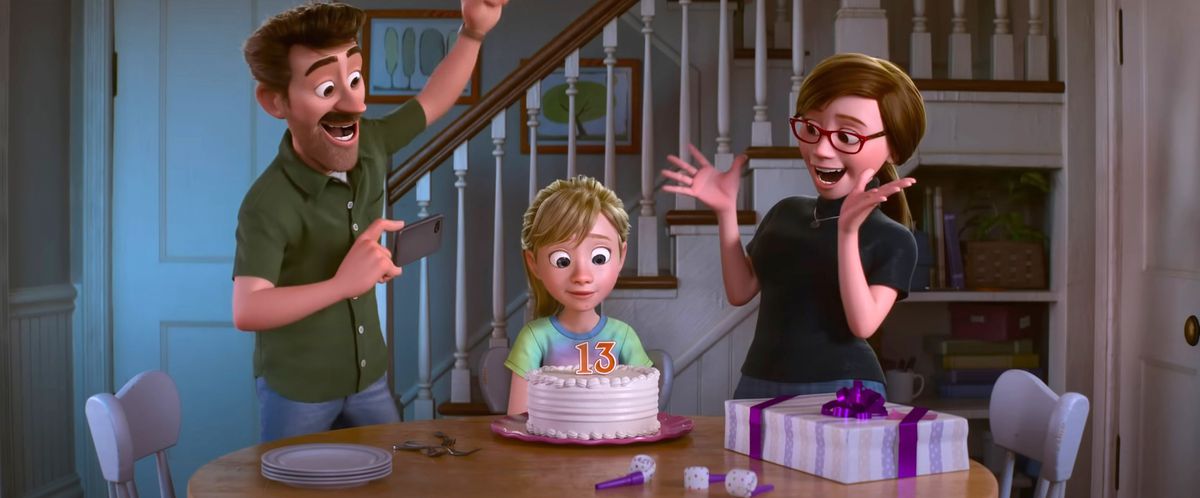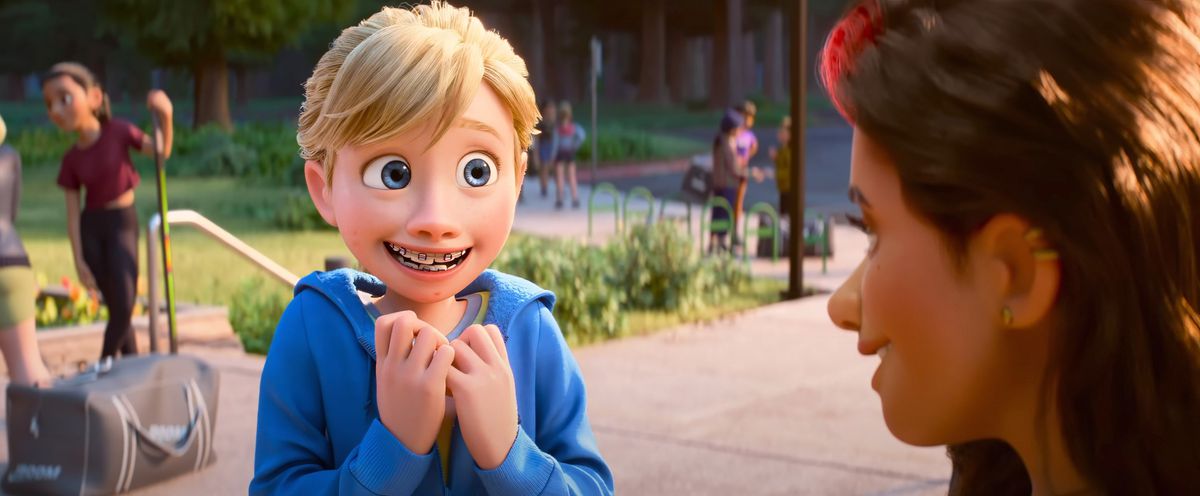The moment Pixar revealed the first new characters in Inside Out 2, fans of the animation studio started arguing about the film’s basic conceit. 2015’s Inside Out centered on five characters who represent the basic emotions of an 11-year-old girl named Riley: Joy, Sadness, Fear, Disgust, and Anger. In the sequel, Riley hits puberty on her 13th birthday, and new emotions suddenly take form in her head: Anxiety, Envy, Embarrassment, and Ennui. Fans of the first film had a lot of questions and complaints: Aren’t these emotions just minor variants of the existing ones? Why are they all negative? And above all, why weren’t any of these emotions around in the first movie?
Of all the concerns, that last one seems most legitimate: Inside Out took viewers inside many different heads, but only found the original five emotions there. There’s been a lot of theorizing about how Inside Out 2 would reconcile that seeming continuity error. In the end, though, the new movie really doesn’t address it. And you know what? It’s fine. It’s not a big deal. And it certainly isn’t a reason to reject a thoughtful, emotionally powerful movie. Here’s why.
[Ed. note: Spoilers for the credits gag in Inside Out and a few small Inside Out 2 jokes ahead.]
Image: Disney/Pixar
The complaint about the new emotions holds water. While the concomitant arrival of puberty and feelings like anxiety and embarrassment is both a source of humor for the movie and an invitation to empathize about how hard it is to be 13, it does bring up a lot of the world-building questions Pixar fans love to gripe about. Once the new movie acknowledges Anxiety as a separate emotion from Fear, with her own problems and her own agendas, it raises a lot of questions.
The biggest one comes from one of Inside Out’s best gags: a closing-credits montage that rushes into many other minds, to see what the balance between the five basic emotions looks like for other people. (Plus a cat and a dog.) Once Inside Out director Pete Docter has established the movie’s complicated visual language and symbolism, he uses this kind of look into other people’s heads to say things about the human experience in pretty subtle ways.
In Riley’s head, Joy is in charge, to the point where she loudly resists and resents any input from Sadness. But in her mother’s mind, Sadness is positioned as the leader of the group, which she runs like a respectful, thoughtful committee. And Riley’s father is piloted by Anger, a brusque military type who treats all the other emotions like lower-ranked officers. Both of these decisions help the audience understand Riley’s parents in a surprisingly intimate way. But mostly, the peeks into other people’s heads are just for quick-burst humor. The fact that we see into so many heads and never see Anxiety there does feel weird in retrospect, and it spoils the joke about how people are so internally similar, yet so wildly different.

Image: Disney/Pixar via Everett Collection
Inside Out 2 does address this discrepancy in a very small way, with short gags where adult versions of Anxiety pop out from behind a curtain to address the five original emotions inside Riley’s parents’ heads. Those moments — one of which is included in the film’s final trailer — is an obvious after-the-fact fix, a “We were here all along, you just didn’t notice us” explanation that isn’t particularly convincing, given that any other emotions hanging out in Riley’s head certainly would have at least been consulted during the chaos of the first movie. But honestly, it doesn’t really have to be convincing, because strict, doctrinaire continuity just is not important for the Inside Out movies.
Both Inside Out movies are built around emotional truths, not literal ones. And the emotional truth here is that when Riley faces problems she’s never faced before — the vast hormonal changes of puberty among them — it feels like she’s not just experiencing brand-new emotions, but that they’re taking over. Much like the magic panda transformations in Turning Red, the conceit of new emotions showing up is metaphorical and centered on the experience of becoming a teenager. It isn’t a scientific map of the brain. And it’s concerned first and foremost with Riley’s subjective experience, not with psychoanalyzing the rest of the world.
Director Kelsey Mann and his co-writers (including Inside Out 2 co-writer Meg LeFauve) aren’t saying adults never experience embarrassment or envy. But they also can’t retroactively refit Inside Out to fit their story. That’s a purely practical, mechanical problem — the kind of thing that sometimes necessarily happens in franchises — rather than an error of carelessness or of the new filmmaking team not understanding the original property. It’s worth taking creators to task over continuity when they take over a beloved story and get the tone or characters entirely wrong. But it feels beside the point to ding them for not having invented time travel.

Image: Disney/Pixar via Everett Collection
Yes, Mann and company could have insisted on making a movie that only uses the original film’s characters — but they would have risked falling into the usual “more of the same, but louder” problem that sequels so often have. Instead, they talked to psychologists and a neuroscientist about how puberty affects the brain, and built a story that acknowledges those changes and how they can feel. And yes, they could have strained for a solution that eventually melds the new emotions into the existing ones — Anxiety and Embarrassment dissolving into Fear, Ennui into Disgust, and Envy into Sadness — but that wouldn’t necessarily have felt true to the human experience either.
For some people, the new emotions may be a narrative deal-breaker, and that’s fine — adding new characters to a new iteration of an existing story can sometimes be a mercenary decision, a lazy one, or both, so it’s reasonable to be dubious. For people suffering from their own anxiety in particular, it may be frustrating to have that experience glossed over as something that doesn’t happen to adults, except in the meekest and most minimal terms.
But instead of totting up this break in continuity for a CinemaSins-style roundup of unforgivable flaws, it’s worth considering everything that went into it, and how little effect it has on the many meaningful ways these two movies interact with each other, beyond making a few scattered gags land less effectively. And it’s also worth considering how well Inside Out 2 works on its own merit, in terms of exploring how these new emotions interact with each other, and what that means to Riley’s life and her relationships with other people.
After all, Mad Max creator George Miller thinks strict franchise continuity isn’t as important as telling a compelling story. Why should we?
Inside Out 2 is in theaters now.

